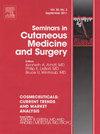蕈样真菌病的临床病理特征、鉴别诊断和治疗。
Q1 Medicine
引用次数: 23
摘要
蕈样真菌病(Mycosis fungoides, MF)是最常见的皮肤T细胞淋巴瘤类型,典型表现为红斑斑块和斑块,组织病理学特征为小到中型的非典型表皮性T细胞浅表浸润。除了这种典型的MF类型,许多临床和/或组织病理学变异已经被描述。这些MF变异的正确诊断很重要,但可能很困难,因为它们可能模仿多种炎症性皮肤病。在这篇综述中,不同变型MF的临床和组织病理学特征提出,他们的鉴别诊断和治疗方案进行了讨论。本文章由计算机程序翻译,如有差异,请以英文原文为准。
Mycosis fungoides variants-clinicopathologic features, differential diagnosis, and treatment.
Mycosis fungoides (MF) is the most common type of cutaneous T-cell lymphoma, which typically presents with erythematous patches and plaques, histopathologically characterized by superficial infiltrates of small to mediumsized atypical epidermotropic T cells. Apart from this classic type of MF, many clinical and/or histopathologic variants have been described. Correct diagnosis of these MF variants is important, but may be difficult, because they may mimic a wide variety of inflammatory skin diseases. In this review, clinical and histopathologic characteristics of distinct variants of MF are presented, and their differential diagnosis and therapeutic options are discussed.
求助全文
通过发布文献求助,成功后即可免费获取论文全文。
去求助
来源期刊
CiteScore
4.90
自引率
0.00%
发文量
0
审稿时长
>12 weeks
期刊介绍:
Seminars in Cutaneous Medicine and Surgery (SCMS) presents well-rounded and authoritative discussions of important clinical areas, especially those undergoing rapid change in the specialty. Each issue, under the direction of the Editors and Guest Editors selected because of their expertise in the subject area, includes the most current information on the diagnosis and management of specific disorders of the skin, as well as the application of the latest scientific findings to patient care.

 求助内容:
求助内容: 应助结果提醒方式:
应助结果提醒方式:


